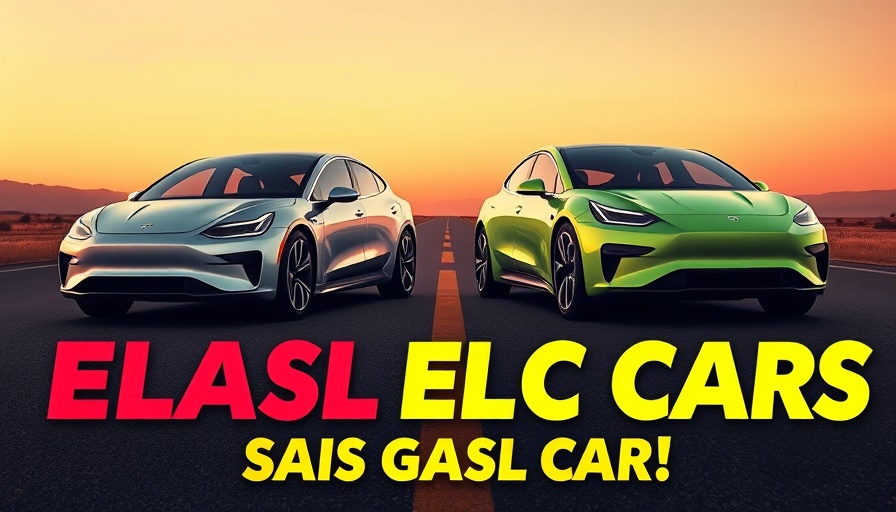
Breaking Down Barriers: Familiar Designs Make EVs Accessible
For many drivers, the thought of transitioning to an electric vehicle (EV) can conjure images of radical shifts in lifestyle. Concerns surrounding range anxiety, charging infrastructure, and costs are just the tip of the iceberg. Often, lingering hesitations stem from the perception that EVs operate in a different sphere—one filled with futuristic designs that boast high-tech features but may lack the comforting familiarity of traditional gas-powered cars.
Recent efforts from automakers strive to bridge this gap, crafting EVs that combine eco-friendly technology with aesthetics and driving experiences reminiscent of their gasoline counterparts. This thoughtful design approach resonates with drivers looking for an electric alternative without venturing into the world of the avant-garde.
Driving Experience: The Key to a Seamless Transition
Central to this conversation is the driving experience itself. Many individuals fear losing the visceral sensations of driving—a rumbling engine, tactile feedback, and conventional dashboard configurations. Thankfully, manufacturers are acutely aware of these concerns and are doing their best to ensure that the transition towards electric vehicles feels more like an upgrade than an overhaul.
You can find numerous EVs that emulate the driving dynamics long associated with combustion engines, providing consumers with the comfort of context amidst the rapidly evolving automotive landscape. Models crafted from shared platforms or outfitted with familiar styles help reinforce this sentiment, easing the journey from gas to electric.
Top Choices for Conventional-Car Lovers: 10 EVs Worth Checking Out
If you are among those hesitant to embrace the electric revolution due to stylistic fears, consider this guide to ten modern electric vehicles that closely mimic the feel of conventional gas cars. Each option showcases not only recognizable designs but also practical features aimed at making your transition to EV driving effortless:
- 2025 Fiat 500e - Priced around $30,500, this compact hatchback channels the classic charm of the Fiat 500 with an eco-friendly twist.
- Ford Mustang Mach-E - With a starting price of approximately $43,000, this electric rendition captures the spirit of the iconic Mustang while embracing modern technology.
- Mazda MX-30 - Touted for its stylish design and approachable starting price of $34,000, this model embodies the excitement of driving with a responsible edge.
- Chevrolet Bolt EV - At about $26,500, this hatchback offers impressive range and technology designed for those seeking practicality without sacrificing comfort.
- Hyundai Ioniq 5 - With its futuristic features and starting price around $39,000, this EV seamlessly integrates the demands of today’s tech-savvy user.
As you explore your options, note that these vehicles not only provide significant savings in ownership costs—thanks to lower fueling expenses and maintenance requirements—but also ensure a zero-tailpipe-emission driving experience.
Why Should You Consider an EV?
Transition to an EV isn’t merely a choice of aesthetics or driving performance—it’s an opportunity to engage in sustainable living. By opting for an electric vehicle, drivers can actively participate in reducing their carbon footprint, a prospect supported by compelling data regarding environmental impact. Furthermore, public perception around EVs is evolving; as more mainstream EVs hit the market, the stigma attached to the idea of 'harsh technology' fades away.
Preparing for a Future of Electric Cars
The future of automotive transport is undoubtedly electric, and the transition will only accelerate further. Consider the socio-economic and environmental benefits of EVs—lower greenhouse gas emissions, reduced dependence on fossil fuels, and quieter driving experiences. Many states are investing heavily in charging infrastructure, thus helping to address range anxiety and making it logistically easier to make the switch.
For those deliberating between switching or sticking to familiar gas models, understanding the familiarities offered is essential. Awareness of EV options can enhance one’s buying strategies while eliminating the fear of an unfamiliar driving experience. With a better understanding of the vehicles available, consumers can decide thoughtfully and in alignment with their values.
Conclusion: The Road Ahead is Electric
By embracing the reality of electric vehicles similar in feel and function to their gasoline predecessors, consumers stand at the forefront of a major shift in the automotive industry. As these options proliferate, it’s imperative to consider joining the ranks of the growing community of EV adopters. The future is electric, and you’ll find a vehicle that meets both your driving needs and your environmental values.
 Add Row
Add Row  Add
Add 




Write A Comment